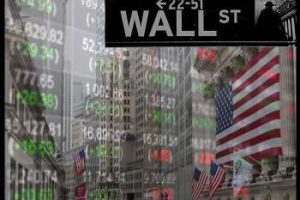U.S. Stocks Stage Late-Day Recovery Attempt But Close Modestly Lower

Stocks showed a significant move to the downside in early trading on Friday but staged a notable recovery attempt going into the close. While the major average climbed well off their lows of the session, they still ended the day in negative territory.
The major averages finished the session modestly lower. The Dow dipped 73.55 points or 0.2 percent to 33,147.25, the Nasdaq edged down 11.61 points or 0.1 percent to 10,466.48 and the S&P 500 slipped 9.78 points or 0.3 percent at 3,839.50.
For the year, the Nasdaq plummeted by 33.1 percent, the S&P 500 plunged by 19.4 percent and the Dow tumbled by 8.8 percent.
The early pullback on Wall Street came as some traders looked to cash in on Thursday’s strong gains, which largely reflected a substantial rebound by technology stocks.
Lingering concerns about the economic outlook also continued to weigh on Wall Street amid worries further interest rate hikes will lead to a recession in the New Year.
The late-day recovery attempt may have reflected window-dressing going into the end of the year, but traders may have seen that as a waste of time given the substantial weakness seen in 2022.
“Equities are a little lower on the final trading day of the year but broadly speaking, over the last week there has been no development, just choppy trading with no conviction or direction,” said Craig Erlam, Senior Market Analyst at OANDA.
“It would appear investors are positioned for an opening quarter of significant uncertainty, which is about right,” he added. “So much now hangs on the economic data and how companies plan to adapt to a potentially impending recession.”
In U.S. economic news, a report released by MNI Indicators showed a bigger than expected slowdown in the pace of contraction in Chicago-area business activity in the month of December.
MNI Indicators said its Chicago business barometer climbed to 44.9 in December from 37.2 in November, although a reading below 50 still indicates a contraction. Economists had expected the index to rise to 41.2.
The bigger than expected rebound came after the Chicago business barometer fell to its lowest reading since the 2008/09 global financial crisis, excluding the 2020 pandemic shock.
Most of the major sectors ended the day showing only modest moves, although notable weakness remained visible among utilities stocks, with the Dow Jones Utilities Average falling by 1.1 percent.
Commercial real estate, transportation and chemical stocks also moved to the downside on the day, while some strength emerged among energy stocks.
Other Markets
In overseas trading, stock markets across the Asia-Pacific region moved mostly higher during trading on Friday. Japan’s Nikkei 225 Index closed just above the unchanged line, while China’s Shanghai Composite Index rose by 0.5 percent.
Meanwhile, the major European markets saw notable weakness on the day. While the French CAC 40 Index tumbled by 1.5 percent, the German DAX Index slumped by 1.1 percent and the U.K.’s FTSE 100 Index slid by 0.8 percent.
In the bond market, treasuries moved back to the downside following the rebound seen in the previous session. Subsequently, the yield on the benchmark ten-year note, which moves opposite of its price, climbed 4.4 basis points to 3.879 percent.
Looking Ahead
Following another long holiday weekend, the Labor Department’s closely watched monthly jobs report is likely to be in focus next week.
Traders are also likely to keep an eye on reports on manufacturing and service sector activity as well as the minutes of the latest Federal Reserve meeting.
Source: Read Full Article
